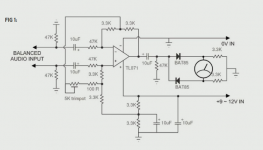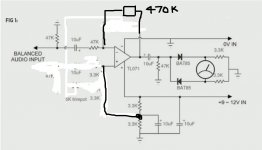At the stage where somebody suggested testing the meter with a 1.5 V. battery, I decided to try a parallel approach. I appreciate everybody`s support here, but, as I`m sure you`ll appreciate, we`ve all only got so much patience.I didnt know you already had a sister thread going " simple solution for VU meter "
I think you have VERY insensitive meters .
To prove otherwise please try this (your not going to like it ) . With the meter only ,no diodes , how much series resistance do you have to use to get a 0VU reading using a 1.5V battery ? ( are you still with me ) .Now having got the 0VU reading how long does it take the needle to achieve said 0VU reading from a standing start.......does it get anywhere near the 300ms standard .
To prove otherwise please try this (your not going to like it ) . With the meter only ,no diodes , how much series resistance do you have to use to get a 0VU reading using a 1.5V battery ? ( are you still with me ) .Now having got the 0VU reading how long does it take the needle to achieve said 0VU reading from a standing start.......does it get anywhere near the 300ms standard .
An upfront comparison for you .
My old VU meter without diodes etc and connected as above .
Battery 1.556V , 21.9 kohm added series resistor for 0VU reading ( meter requires 100uA for FSD,meter resistance 1 kohm ).
Possibly more important i can dab the battery on and off and keep the beat with the seconds hand on a clock with the meter needle going from -20 to + 1.5 (the needle overshoots the 0VU mark on transients )
Ps. this is not to my knowledge a professional meter, i never bought it as such.
My old VU meter without diodes etc and connected as above .
Battery 1.556V , 21.9 kohm added series resistor for 0VU reading ( meter requires 100uA for FSD,meter resistance 1 kohm ).
Possibly more important i can dab the battery on and off and keep the beat with the seconds hand on a clock with the meter needle going from -20 to + 1.5 (the needle overshoots the 0VU mark on transients )
Ps. this is not to my knowledge a professional meter, i never bought it as such.
P { margin-bottom: 0.08in; } I've just tested the (original) circuit (s. Attach). It makes absolutely no difference, I still have no meter reaction until really high volumes. Can it be that both meters simpy have a very poor reaction/are really insensitive, as epicyclic (#22) wrote? Considering purchase of another meter!
Attachments
OK,
how do we set up a VU meter to read correctly?
Is it set with a continuous sinewave @ a specific frequency?
Is it set to 0dB, or to +3dB?
What should that indicate? The onset of clipping, or the onset of distortion, or the onset of excessive distortion?
The audio level for 0VU ( referred to as "0dB") is equal to +4 dBm (+4dBu), or 1.228 volts RMS across a 600 ohm load.
It is driven from a full-wave averaging circuit defined to reach 99% full-scale deflection (attack time) in 300 ms and overshoot not less than 1% and not more than 1.5% (signal 1kHz sine). Release time too is 300ms. (*)
VU response relates to the perceived loudness of the audio signal. Attack and overshoot (needle ballistics) were optimized for broadcast and sound recording.
Despite the specs, with non-pro audio equipment, the audio level required to achieve indicated 0db can be whatever the manufacturer wishes.
>Edit:If you ask me, a true VU meter is no good for distortion onset indicator due to it's slow response time. A generous headroom >>12 db has to be accounted for in any case.
Have a look here (under "SVI" heading)
http://www.ips.org.uk/files/10b_Audio_Waveforms_And_Meters_Extra.pdf
George
(*) Quasi peak meters have 4-10ms attack time and very long (1-1.5s) release time
Last edited:
As George has said, a true VU meter is designed to "bridge" across a 600 Ohm line, and has a self-contained rectifier. Meter ballistics are specified and the meter is intended to be isolated with a 3600 Ohm resistor. If you don't do things this way, it doesn't read right or have correct ballistics.
If you wanted something really useful you could drive your VU meters with signal level to give 0VU at some reference volume, say 80dB SPL at listening position. (Many folks would be surprised how loud 80dB SPL is.) Or 85dB SPL which is mastering reference volume. (Loud).
All good fortune,
Chris
If you wanted something really useful you could drive your VU meters with signal level to give 0VU at some reference volume, say 80dB SPL at listening position. (Many folks would be surprised how loud 80dB SPL is.) Or 85dB SPL which is mastering reference volume. (Loud).
All good fortune,
Chris
Just tried it. Absolutely no difference
OK, lets find out why not. I take it you haven't a scope ?
The circuit as redrawn has a gain of 10. Try connecting headphones (with a series resistor to limit volume) across the 47K at the output. That should let you prove the opamp is working OK.
Have you tried reducing the value of the 3.3k resistors ? Go as low 100 ohm, just to see.
You really need to test the meter (its sensitivity) and use a scope to see what's going on in the circuit but you surely should be able to get the meter to move.
A scope makes it very easy as you can see what is going on. If it only moves at high volume then you need to increase the sensitivity (gain). You can increase the 470K upwards and/or also lower the 47K that goes to the inverting input. The ratio of those sets the gain. Its got move at some point. I would also look at whether the diode arrangement is OK. Anything above the turn on voltage of the diodes and the meter should be moving.
O.k., with 470K replaced by 1M it works!A scope makes it very easy as you can see what is going on. If it only moves at high volume then you need to increase the sensitivity (gain). You can increase the 470K upwards and/or also lower the 47K that goes to the inverting input. The ratio of those sets the gain. Its got move at some point. I would also look at whether the diode arrangement is OK. Anything above the turn on voltage of the diodes and the meter should be moving.
O.k., with 470K replaced by 1M it works!
So you needed more gain
- Status
- This old topic is closed. If you want to reopen this topic, contact a moderator using the "Report Post" button.
- Home
- Source & Line
- Analog Line Level
- VU Meter ballistics

